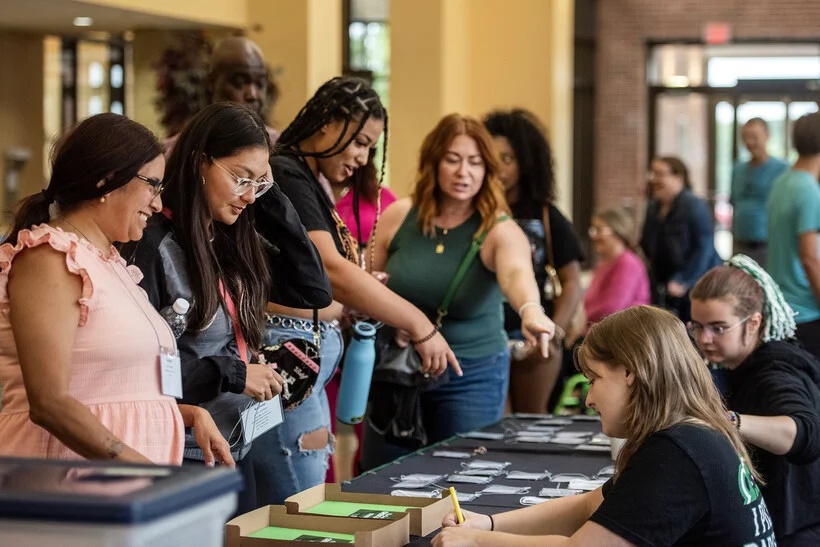How Diverse Are UW System Campuses?
Diversity has improved, but underrepresented minorities are still less than 15%.

Students check in at orientation Friday, Aug. 25, 2023, at UW-Parkside in Somers, Wisconsin. Angela Major/WPR
For months, the Universities of Wisconsin and Republican Assembly Speaker Robin Vos have been at odds over diversity initiatives on public campuses.
An ongoing Republican argument has been that the UW System is lacking in “diversity of political thought,” which should be the focus instead of racial diversity and the perceived “ideological campaigns” that Vos, R-Rochester, says are taking place across college campuses.
In exchange, DEI positions would have been frozen through 2026 and about 40 existing positions would have been cut. UW-Madison would have also ended a program aimed at hiring more diverse faculty and staff. That deal was rejected Saturday by the Board of Regents.
While the political battle over university system efforts to increase diversity on campus continues, the success of those efforts on campus have been mixed.
Racial diversity has improved on UW campuses, but not equally. The number of underrepresented minority students attending the UW-System is still less than 15 percent. And while faculty overall has become more diverse, there has not been an increase in the percentage of Black faculty members.
How diverse is the student population on UW campuses?
Jason Stein, vice president and research director of the nonpartisan Wisconsin Policy Forum, said when talking about campus diversity, it’s important to be specific.
“On one hand, if you look over time, the number of students of color on campuses has risen substantially. But it hasn’t risen for all groups to the same degree,” Stein said. “Some groups, like Latino students, have very large increases fairly steadily over time. Whereas the share of African American students hasn’t really gone up.”
At UW-Madison, the state’s flagship university, those numbers are mostly the same, the report found.
That could be because there aren’t enough opportunities for Black students. A report released in August by the Black and Latino Ecosystem and Support Transition, or BLEST, Hub at Marquette University found college prep programs in Milwaukee, which has the largest Black population in the state, have shown improvement in growing academic achievement for Hispanic children, but not Black students.
As Milwaukee’s Hispanic population has grown over the last 20 years, there have been increasing efforts by many charter and choice high schools and the city’s universities to intentionally interact with Latino students. The same has not been true for Black students.
Stein said in a state like Wisconsin, which is majority white, tripling the number of students of color at public universities sounds like a lot. But if you are a Black student, it doesn’t feel like the same progression.
A recent U.S. News and World Report looked at “The Most Ethnically Diverse National Universities in America,” using 2022 student data. No Wisconsin universities or colleges ranked in the top 50 nationwide.
In looking at specifically at universities in the Midwest, five Wisconsin schools ranked in the top 50: Mount Mary University, Alverno College, UW-Parkside, Carthage College and the Milwaukee School of Engineering.
According to state data, nearly 30 percent of UW-Parkside’s students were underrepresented minorities in 2022. That’s higher than UW-Milwaukee, where 25.4 percent of students were underrepresented minorities last year.
But overall, underrepresented minorities throughout the entire UW system make up 14.3 percent of enrolled students. Last year, 22,965 of the system’s 160,782 students were underrepresented minorities.
How diverse are UW staff and faculty?
The deal Rothman brokered with Vos would have created an administrative chair position to focus on “conservative political thought, classical economic theory, or classical liberalism.”
It also would have ended a program aimed at recruiting faculty of color.
The Wisconsin Policy Forum report found diversifying faculty and staff results in being able to attract and better serve students from different backgrounds.
The university system’s non-white faculty rose from 10.8 percent in 2000 to 20.2 percent in 2019, according to the report. There were similar trends at UW-Madison.
Still, that diversity has mainly been with certain groups such as Asian professors and instructors, who have more than doubled their share of the overall faculty, while Black faculty have made smaller gains and Native American faculty have lost ground, according to the report.
Conservative criticism against diversity is not new
Walter Lanier, president and CEO of the African American Leadership Alliance Milwaukee, said attacking diversity and inclusion programs in schools has been a “crafty” conservative idea since critical race theory became a political issue two years ago.
Lanier said as a result of CRT becoming a “boogieman scare tactic,” there is now pushback on diversity initiatives on public campuses. He said that political pressure is likely to make it tougher to ensure the system’s student population reflects the state’s population overall.
“That (DEI programs) is exactly what is needed to improve the recruitment and retention of students, citizens and future employees,” Lanier said.
Lanier said he was glad to see the Board of Regents reject the deal brokered by Vos and Rothman.
“When political power is weighted, sometimes it is hard to stand,” Lanier said. “It was good to see a move that more appropriately reflects the 21st century values of the state. And where we need to be headed to strengthen our future educational system and our future employees.”
Listen to the WPR report here.
How diverse are University of Wisconsin campuses? was originally published by Wisconsin Public Radio.





















